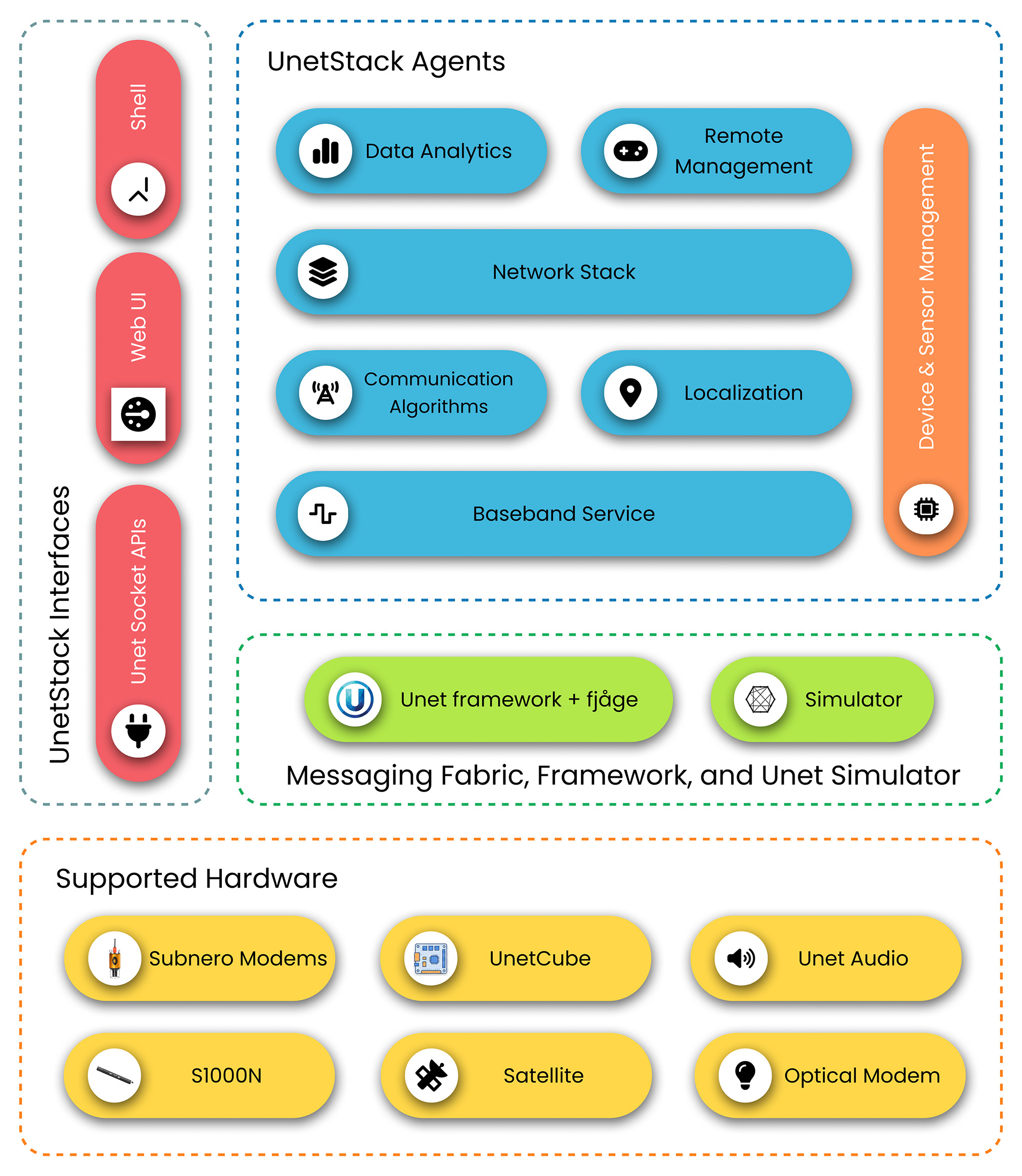A modern framework for software-defined underwater networks

UnetStack
Design, simulate, and deploy communication networks across subsea and terrestrial domains using a flexible, agent-based architecture.
Software-Defined Intelligence
Full-stack programmability
Unified Development Workflow
Simulate, test and deploy seamlessly
Advanced Underwater Networking
Cross-layer stack for scalable networks
Ideal for R&D
Designed for rapid innovation
UnetStack Overview
UnetStack is a suite of technologies that brings modern communication networks underwater. At its core is an extensible, agent-based framework for building underwater and hybrid communication systems, providing full control from the physical layer up to applications. Surrounding this core is an ecosystem of simulators, hardware components such as Unet audio and UnetCube, and libraries and APIs in multiple programming languages, supporting the entire workflow from development to deployment.
- Supports standalone underwater networks & hybrid systems (Acoustic, Optical, RF, Wired).
- Includes localization, device & sensor management, and edge analytics.
- Unified programmable framework for intelligent communication behaviours.

Development Ecosystem
From desktop simulation to hardware deployment, UnetStack provides the tools for every stage of the lifecycle.
UnetSim
Network Simulator
Fast, flexible simulator for developing, simulating, testing and refining subsea protocols.
- ● Real-time & Discrete-event modes
- ● Seamless code migration to hardware
- ● Rapid prototyping workflow
Ideal for
- ● Education
- ● Protocol Development
- ● System Integration
Virtual Acoustic Ocean
Hardware-in-the-Loop Simulator
Acoustic simulator that is part of the UnetStack ecosystem, to connect modems to physics-accurate underwater channel models.
- ● Physics-accurate acoustic models
- ● Hardware-in-the-loop testing
- ● Open-source interface
Ideal for
- ● System Integration
- ● HIL Simulation
- ● Physical Layer Development
UnetCube
OEM Development Platform
Embedded computing platform running UnetStack natively for custom modems.
- ● Embedded Single Board Computer (SBC)
- ● Custom analog/DAQ integration
- ● Unified simulation workflow
Ideal for
- ● Desktop HIL simulation
- ● Customized modem development
- ● Subsea Network Controller
Editions
UnetStack is available in three editions tailored to usage requirements.
Community Edition
A free edition for academic use and prototyping — not for commercial deployments.
- Unet Simulator (Community)
- Basic UnetStack agents
- Documentation & Tutorials
Commercial Edition
A licensed edition for operational deployments across defense, commercial and industrial domains.
- Unet Simulator (Commercial)
- UnetStack Agents
- LTS & Technical Support
OEM Edition
(UnetCube)
An embedded development platform for hardware in the loop simulation or OEMs.
- Embedded Single Board Computer (SBC)
- Hardware-in-the-Loop Support
- Open Source Interfaces
Components of the UnetStack Ecosystem
The UnetStack ecosystem is built around three core pillars: the UnetStack software framework, the suite of UnetStack agents, and a set of complementary ecosystem components. Together, they provide a complete foundation for developing, simulating, and deploying underwater and hybrid communication networks.
Messaging Fabric, Framework, and Unet Simulator
UnetStack is built on the fjåge messaging fabric, on top of which sits the Unet framework, which provides the core environment where all UnetStack agents operate. The ecosystem also includes UnetSim, a powerful network simulator supporting both discrete-event and real-time execution.
UnetStack Agents
UnetStack offers a range of agents covering physical-layer processing, MAC and routing, localization, multimodal communication drivers, and analytics. These include both basic agents available in all editions and licensed agents designed for enhanced performance or OEM deployments.
Ecosystem Components
Beyond the core framework, the ecosystem includes tools such as Virtual Acoustic Ocean (VAO) for high-fidelity acoustic simulation, Unet audio for sound-card-based modem development, UnetCube for embedded OEM deployments, and a broad set of APIs and libraries available in multiple programming languages.

Documentation
Everything you ever need to know about UnetStack.
